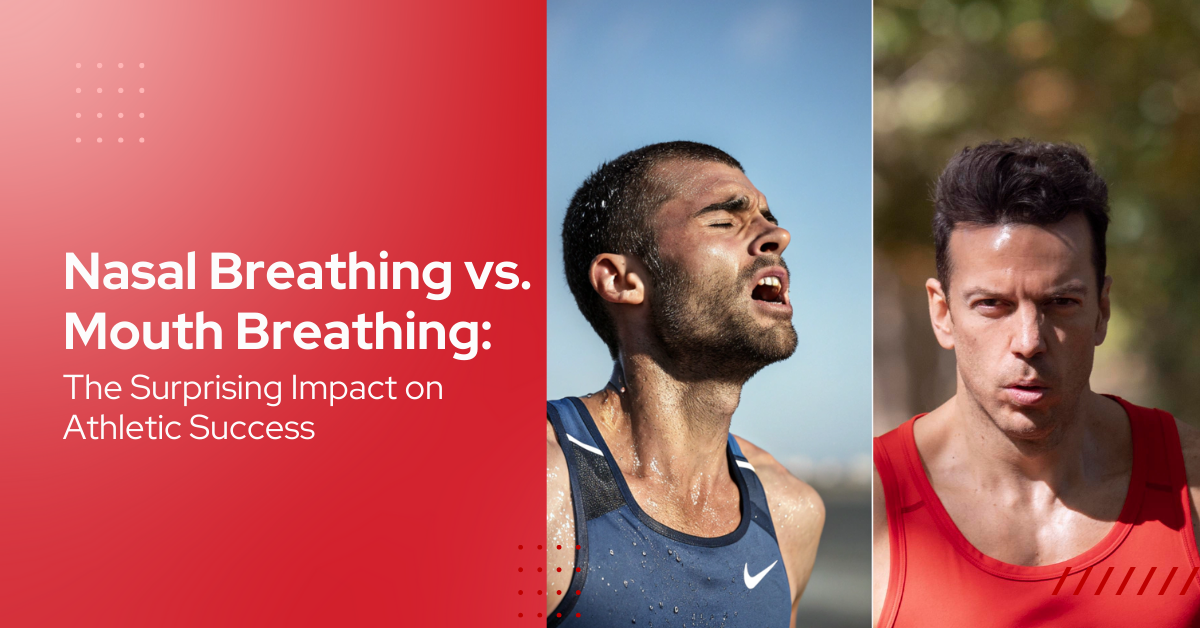Breathing is an automatic process we often take for granted, but how we breathe through the nose or the mouth can dramatically affect athletic performance. While mouth breathing might feel natural during intense workouts or sports, it’s nasal breathing that truly holds the key to maximizing endurance, focus, and recovery.
This article will explore the physiological differences between nasal and mouth breathing, how they impact athletic success, and why incorporating tools like Sport Pal into your routine can revolutionize your training.

The Science Behind Breathing
Breathing is about more than oxygen; it’s about efficiency. The way air enters your body can influence oxygen delivery to muscles, energy levels, and even mental clarity.

Why Nasal Breathing is Better for Athletes
- Improved Oxygen Uptake
- Nasal breathing increases nitric oxide levels in the bloodstream, which expands blood vessels and improves oxygen delivery to muscles.
- Studies show that nasal breathing can enhance oxygen absorption by up to 20%, critical for endurance athletes.
- Better Endurance
- Nasal breathing promotes steady airflow, reducing the "fight-or-flight" response triggered by mouth breathing.
- A 2018 study in the Journal of Sports Medicine found that athletes who trained to breathe nasally could maintain higher stamina compared to mouth breathers.
- Enhanced Recovery
- Nasal breathing activates the parasympathetic nervous system, known as the "rest and digest" system, aiding post-workout recovery.
- Mouth breathing, by contrast, keeps athletes in a stressed state, slowing down muscle repair and recovery.
- Focus and Mental Clarity
- Breathing through the nose helps regulate carbon dioxide levels in the blood, supporting a calm, focused mind—a critical factor in high-pressure sports situations.
The Drawbacks of Mouth Breathing
While mouth breathing can provide short bursts of air during high-intensity moments, it has several long-term disadvantages:
- Shallow Breathing: Limits oxygen exchange, leading to rapid fatigue.
- Dry Mouth and Dehydration: Increases water loss, which can impair performance.
- Postural Issues: Mouth breathing encourages poor tongue posture, potentially leading to misalignment and reduced core stability.
- Stress Response: Keeps the body in a heightened state of stress, hindering recovery.

Sport Pal: The Ultimate Tool for Nasal Breathing
Sport Pal is more than just a tongue-training device—it’s a game-changer for athletes looking to optimize their breathing. Designed to improve tongue posture and encourage nasal breathing, Sport Pal helps athletes achieve peak performance by training the body to breathe better, even under pressure.
How Sport Pal Supports Nasal Breathing:
- Trains Tongue Positioning
- Keeps the tongue resting on the roof of the mouth, naturally encouraging nasal breathing.
- Improves Core Stability
- Proper tongue posture enhances overall body alignment, reducing injury risk.
- Builds Endurance
- Sport Pal helps train the body to use oxygen more efficiently, delaying fatigue.
- Supports Recovery
- Encourages relaxation and deep breathing post-workout, aiding recovery.
Practical Tips for Switching to Nasal Breathing
Switching from mouth breathing to nasal breathing requires practice, but the results are worth it. Here’s how you can start:
- Use Sport Pal During Training
- Wear Sport Pal during workouts to train your tongue to maintain proper posture, making nasal breathing feel more natural.
- Practice Breathing Drills
- Begin with slow, controlled breaths in and out through the nose. Gradually increase intensity as your body adapts.
- Example Drill:
- Inhale through the nose for 4 counts, hold for 2, and exhale for 4. Repeat for 5 minutes daily.
- Sleep Nasally
- Use techniques like mouth taping (under professional guidance) to train nasal breathing during sleep.
- Strengthen Your Diaphragm
- Incorporate exercises like diaphragmatic breathing to improve lung capacity and control.
The Long-Term Benefits of Nasal Breathing
For athletes, nasal breathing is not just about improving performance today—it’s about setting a foundation for long-term health and success.
Benefits Over Time:
- Increased Lung Capacity: Regular nasal breathing strengthens respiratory muscles.
- Better Sleep Quality: Reduces risks of sleep apnea and snoring, enhancing recovery.
- Improved Oral Health: Prevents dry mouth and tooth decay often associated with mouth breathing.

Case Study: The Sport Pal Advantage
Meet Alex, a high school track athlete who struggled with endurance. After incorporating Sport Pal into her routine, Alex transitioned to nasal breathing during workouts. Within 3 months, she reported:
- 15% Improvement in Endurance: Measured by her 5K race times.
- Enhanced Recovery: Less soreness after intense training sessions.
- Better Focus: Improved mental clarity during races.
Breathe Better to Perform Better
Nasal breathing is the unsung hero of athletic performance. By prioritizing it over mouth breathing, athletes can unlock higher levels of endurance, recovery, and focus. With tools like Sport Pal, the transition becomes easier and more effective, giving athletes of all ages the edge they need to succeed.
Take control of your breath. Train smarter. Perform better.

Share:
Why Every Athlete (and Parent!) Should Care About Tongue Training
Building Mental Resilience: How Breath Training Supports Focus and Calm Under Pressure